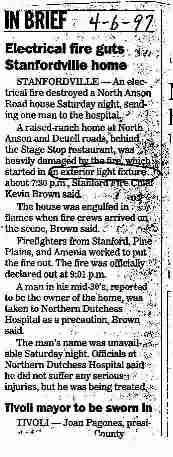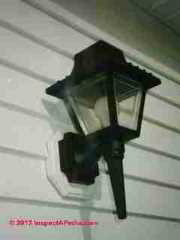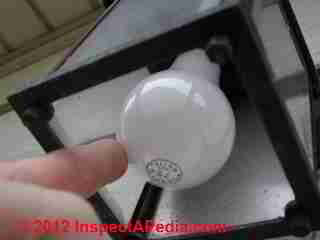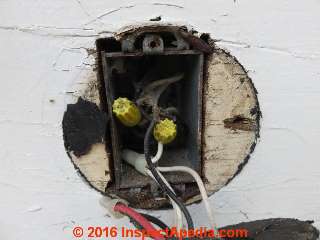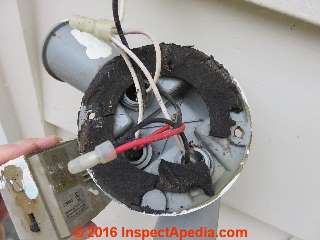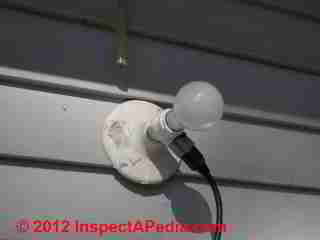 Unsafe Exterior Lighting Fixtures
Unsafe Exterior Lighting Fixtures
How to inspect outdoor floodlight or security light fixtures
- POST a QUESTION or COMMENT about exterior lighting installation, troubleshooting, repair, & electrical codes
How to inspect exterior lighting for unsafe conditions:
In a series of photographs and comments this article describes unsafe or otherwise defective outdoor floodlight and security light or other outdoor light installations whose defects can be spotted (mostly) by mere visual inspection.
This article series discusses outdoor lighting installation, troubleshooting and repair procedures. This series also explains how to install recessed lights in an exterior soffit or roof overhang. We provide lighting installation suggestions about the type of light fixture to use, light fixture support, clearances, fire safety, moisture resistance, switch location, and electrical code citations for exterior lighting on buildings.
InspectAPedia tolerates no conflicts of interest. We have no relationship with advertisers, products, or services discussed at this website.
- Daniel Friedman, Publisher/Editor/Author - See WHO ARE WE?
Outdoor Light Fixture Installations We Hate
[Click to enlarge any image]
Here are a examples of outdoor "lighting" practices to avoid.
Above: a jury-rigged hanging exposed wiring (above) and (below) the use of indoor "zip cord" electrical wiring to add a (non-weather-tight) outdoor light at the house fascia.
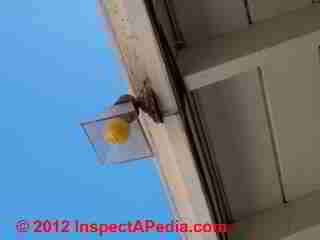
Below left, well at least there is some conduit.
That flood bulb is actually touching the wood fascia board interior surface.
At the outdoor but under-roof light fixture below we lack weather protection and the bulb base is broken.
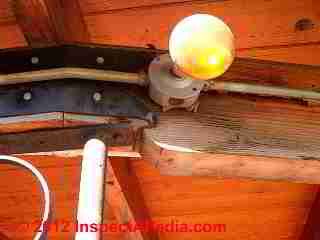
We inspected a home that caught fire after the owner installed an over-watted incandescent bulb in a plastic coach light fixture like the one at left.
Click the news story to read about a similar fire that began in the outside light.
Here is the coach light fixture that is plastic and that can actually melt and perhaps catch fire from an over-sized incandescent light bulb.
Below left we see an indoor light fixture screwed to a vinyl sided wall, and added to that unsafe installation is the use of an extension cord adapter on the fixture.
Outside electrical receptacles for extension cords require grounded and GFCI receptacles.
Below we illustrate a closer look at a wall-mounted floodlight that includes cracked unsafe electrical wires, an opening into the box missing a weather cover, and exposed electrical wires almost touching the metal light fixture. At least he taped them.
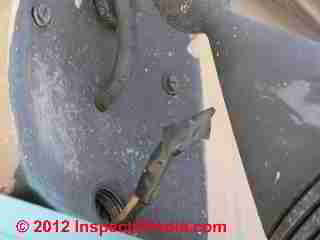
Similar to the plastic light fixture fire we cited above, even in a well built metal light fixture such as the coachlight at left, if the bulb and wiring become loose and damaged it is possible to short-circuit the wobbly bulb simply by touching it.
Notice in the photo below that the bulb is askew. We could push it to center - it was hanging by a wire. This exterior light fixture needs repair or replacement.
Below: an indoor-work electrical box was used to install an outdoor floodlight.Notice too that the box is "fastened" to the wall by loose electrical staples.
Above: you'll also notice that the gasket for this surface-mounted floodlight is damaged and that water has been leaking into the fixture. More about this horrible outdoor light installation is
at REPAIR AUTOMATIC OUTDOOR LIGHT FIXTURE.
Article Series Contents
- LIGHTING, EXTERIOR GUIDE
- RECESSED SOFFIT LIGHT INSTALLATION OUTDOORS
- RECESSED SOFFIT LIGHT BULB & TRIM CHOICES
- SURFACE-MOUNT OUTDOOR LIGHT FIXTURE INSTALLATION
- REPAIR AUTOMATIC OUTDOOR LIGHT FIXTURE - separate article
- SECURITY / MOTION SENSOR LIGHT INSTALL - separate article
- LIGHTING, EXTERIOR FAQs - separate article
- UNSAFE OUTDOOR LIGHT FIXTURES - separate article
Also see our discussion of lighting requirements over stairs, at LIGHTING OVER STAIRS & AT EXITS and see LIGHTING, INTERIOR GUIDE for details about lighting fixtures, bulbs, and indoor requirements.
...
Continue reading at LIGHTING, EXTERIOR GUIDE - topic home, or select a topic from the closely-related articles below, or see the complete ARTICLE INDEX.
Or see these
Recommended Articles
- LIGHTING, EXTERIOR GUIDE - home
- LIGHTING, INTERIOR GUIDE - home
- LIGHTING OVER STAIRS & AT EXITS
- REPAIR AUTOMATIC OUTDOOR LIGHT FIXTURE
- SECURITY / MOTION SENSOR LIGHT INSTALL
- UNSAFE OUTDOOR LIGHT FIXTURES
Suggested citation for this web page
UNSAFE OUTDOOR LIGHT FIXTURES at InspectApedia.com - online encyclopedia of building & environmental inspection, testing, diagnosis, repair, & problem prevention advice.
Or see this
INDEX to RELATED ARTICLES: ARTICLE INDEX to BUILDING LIGHTING
Or use the SEARCH BOX found below to Ask a Question or Search InspectApedia
Ask a Question or Search InspectApedia
Try the search box just below, or if you prefer, post a question or comment in the Comments box below and we will respond promptly.
Search the InspectApedia website
Note: appearance of your Comment below may be delayed: if your comment contains an image, photograph, web link, or text that looks to the software as if it might be a web link, your posting will appear after it has been approved by a moderator. Apologies for the delay.
Only one image can be added per comment but you can post as many comments, and therefore images, as you like.
You will not receive a notification when a response to your question has been posted.
Please bookmark this page to make it easy for you to check back for our response.
IF above you see "Comment Form is loading comments..." then COMMENT BOX - countable.ca / bawkbox.com IS NOT WORKING.
In any case you are welcome to send an email directly to us at InspectApedia.com at editor@inspectApedia.com
We'll reply to you directly. Please help us help you by noting, in your email, the URL of the InspectApedia page where you wanted to comment.
Citations & References
In addition to any citations in the article above, a full list is available on request.
- [1] Codes & Standards pertaining to fire-rating enclosures:
- ASTM E119-05a
- UL 263 (also see Canadian CUL specifications)
- UBC 7-1
- NFPA 251
- ANSI A2.1
- IP66
- [2] Steven Bliss served as editorial director and co-publisher of The Journal of Light Construction for 16 years and previously as building technology editor for Progressive Builder and Solar Age magazines. He worked in the building trades as a carpenter and design/build contractor for more than ten years and holds a masters degree from the Harvard Graduate School of Education. Excerpts from his recent book, Best Practices Guide to Residential Construction, Wiley (November 18, 2005) ISBN-10: 0471648361, ISBN-13: 978-0471648369, appear throughout this website, with permission and courtesy of Wiley & Sons. Best Practices Guide is available from the publisher, J. Wiley & Sons, and also at Amazon.com .
- [3] Carson Dunlop provides home inspection education including the ASHI-adopted a Home Inspection Home Study Course, and publications such as the Home Reference Book, the Home Reference eBook, and report writing materials including the Horizon report writer, and home inspection services. Alan Carson is a past president of ASHI, the American Society of Home Inspectors.
- [4] Paul Galow [Website galowconsulting.com ] - technical consultant on networking, LAN design, applications support. Galow Consulting Services [Website galowconsulting.com ] , 914-204-1749, email: paulgalow@galowconsulting.com
- [5] New Jersey State Energy Code, N.J.A.C. 5:23-3.18, Recessed Lighting Fixtures (RLFs), Uniform Construction Code Communicator, Vol. 16, No. 1, Spring 2004, p. 8, Division of Codes and Standards, POB 802, Trenton NJ 08625-0802. Web site for free downloads of the energy
compliance tools REScheck, New Jersey edition and
COMcheck-EZ is www.energycodes.gov.
Quoting:
N.J.A.C. 5:23-3.18 adopts by reference the 1995 edition of the Council of American Building Officials’ Model Energy Code (CABO MEC/1995) as New Jersey’s Energy Subcode of the Uniform Construction Code. Sections 502.3.4 and 602.3.3 of CABO MEC/1995, both entitled “Recessed Lighting Fixtures,” contain requirements for RLFs in relation to the Energy Subcode. The following are the three options for the installation of RLFs when installed in the building envelope. Only one must be followed to meet the requirements of the Energy Subcode:
1. Type IC rated, manufactured with no penetrations between the inside of the recessed fixture and ceiling cavity, and sealed or gasketed to prevent air leakage into the unconditioned space; or
2. Type IC rated or non-IC rated, installed inside a sealed box constructed from a minimum ½-inch-thick gypsum wall board or constructed from preformed polymeric vapor barrier, or other air-tight assembly manufactured for this purpose, while maintaining required clearances of not less than ½ inch from combustible material and not less than three inches from insulation material; or
3. Type IC rated, in accordance with ASTM E 283- 91 (Standard Method of Test for Rate of Air Leakage Through Exterior Windows, Curtain Walls, and Doors), with no more than 2.0 cfm air movement from the conditioned space to the ceiling cavity. The lighting fixture shall be tested at 75 Pa or 1.57 lbs/ft2 pressure difference and shall be labeled.
Sections 502.3.4 and 602.3.3 of CABO MEC/1995 are the responsibility of the building subcode official, who inspects RLFs to ensure that they are either insulation cover rated (IC rated), or installed in a sealed box that has the insulation at least three inches from the light fixture. It is the building subcode official’s responsibility to ensure compliance, both in the inspection plan review and inspection plan review stages, because RLFs pose a potential fire hazard if installed incorrectly with insulation. These fixtures also act as chimneys, transferring heat loss and moisture through the building envelope into attic spaces if not installed properly. The heat loss resulting from improperly insulated RLFs can be significant.
NOTE: Electrical subcode officials are responsible for the wiring methods of RLFs. - [6] "Out of Sight, Out of Mind - the dangers and requirements of recessed light fixtures", Kellie K. Speed, Electrical Contractor, Feb. 2009, Quoting:
When installing recessed fixtures, carefully consider the location of the units. The presence of combustible materials surrounding the luminaire is very important, and recessed lights can act as chimneys for heat loss and moisture transfer into attic spaces. Many residential fires have resulted from improperly installed or modified recessed light fixtures, but they can be easily avoided. In older homes that may have existing recessed lighting fixtures, homeowners sometimes cover these fixtures with insulation. As a result, the insulation traps the heat created by the bulb and either melts the insulation on the electrical wiring or ignites combustible materials, which is, of course, a fire hazard. It is vital to ensure the area surrounding the recessed fixture is insulated properly. In addition to fire, the interior of a property could be compromised if air leakage occurs, resulting in moisture, condensation and mold. Sealing the building properly reduces air movement in and out of the building. Uncontrolled air movement will negatively impact the heating and cooling systems, resulting in higher initial and ongoing maintenance costs. There certainly is a lot to consider when installing recessed lighting. For help, consult the National Electrical Code (NEC). Article 410 Parts M and N offer special provisions for recessed luminaires installed in walls or ceilings. Most of these Code requirements are designed to protect combustible building materials from temperatures greater than 90°C (194°F). - [7] National Electrical Code, (NEC). Article 410 Parts M and N: provisions for recessed luminaires installed in walls or ceilings.
- [8] "E-Series LED Recessed Light, Installation instructions for E6-E26-30-WH, retrofit installation or new construction installation, American Lighting, www.americanlighting.com
- [9] "Information Bulletin - Recessed Light Fittings", ACE Insurance Limited, CU1-3, Shed 24, Princes Wharf, Auckland 1010, website: http://www.aceinsurance.co.nz/,
Ace reported a "near miss" inner city apartment complex fire traced to recessed light fittings. Quoting:
An investigation into the cause of a fault on an apartment complex’s fire alarm system revealed the cause as a slow smouldering fire involving the heat detector wiring. Further investigation indicated the probable cause of the fire to be due to a nearby recessed incandescent light fitting which had overheated. The insulation on the electric wiring at the point of connection to the light fitting had been burnt away and the burning had continued for several metres along the electrical wiring to the switch and another interconnected light fitting within the same room. Thermal insulation material (fibreglass batts) was present in the roof space around the recessed light fittings. The recessed light fittings had been installed in the room for more than 15 years without any previous issues. Repairs to the roof had been carried out some 5 years previously which required contractors to access the roof space directly above the room.
Australian/New Zealand Wiring Rules (AS/NZS 3000:2007 provides minimum clearance for recessed light fittings but emphasizes that The importance of following relevant codes and standards and the recessed light manufacturer's installation requirements cannot be over-emphasized.Dimension Incandescent lamp Halogen lamp Clearance - luminaire to building element above 50 mm 200 mm Side clearance - luminaire to structural member 100 mm 200 mm Clearance -luminaire to thermal insulation 50 mm 200 mm Clearance - luminaire to supply transformer 50 mm 50 m - [10] E.Z. Barrier, fire-rated: Fire-rated Recessed Light Enclosure, E.Z. Barrier, 901 N 3rd St, Ste 130 Minneapolis, MN 55401 Ph. 612.436.0606 Fax 612.436.0608 sales@ezbarrier.com, Website: www.ezbarrier.com Product literature describes one-hour rated enclosure for recessed lights that save time over a site built fire-rated recessed light enclosure complies with the fire resistance codes listed in citation [1] above.
- [11] "Liteline Recessed Lighting, Luminaire Encastre, 6-in. Remodel IC/non-IC housing, air tight, Installation Instructions", Liteline Corporation, info@lifeline.com, web: lifeline.com, Tel: 866-730-7704
- [12] "Wiring Methods Utilizing Suspended Ceilings (Revised", State of Oregon, Building Codes Division, code interpretation, 10/1/2002, Gary A. Wilson, Chief Electrical Inspector & Doug Alexander, Structural Code Specialist. This interpretation specifies that in light duty systems certain light fixtures (such as recessed fluorescent lighting), the ceiling system shall not be used for the support of the lighting fixtures. Intermediate-duty ceilings may be used for supporting recessed lighting fixtures provided certain support detail specifications are followed. Heavy duty ceiling systems require that the recessed light fixture be secured to specifications included in the interpretation. Web search 4/29/12, original source: http://www.etnews.org/docs/wiring_methods_suspended_ceilings.pdf
- [13] "Recessed Light (Non-Insulating), Installation Instructions, CANARM Lighting & Fans, Tel: 800-265-1833 (English) or 800-567-2513 (French) or 800-267-4427 (USA) describe a recessed light fixture retrofit through a drywall ceiling.
- [14] "Downlights, Recessed Downlight Housings - Installation", Lucifer Lighting Company, 414 Live Oak St., San Antonnio TX 78202, Tel: 210-227-7329, www.luciferlighting.com
- [15] "Outdoor Recessed Light Kit Installation Instructions, apply to downlights / stair lights", Dekor, 2655 Santa Fe Unit 4H, Denver CO 80223, 2011, Customer Support: 800-258-0344, Website: www.DE-Kor.com. This document describes installation for a 12V DC constant current 3A transformer with a waterproof design IP66-rated, UL and CUL approved, and LED lighting fixtures that are waterproof and can be submerged in water. cf: OUTDOORRecessedLight Install1.pdf
- [16] "Recessed Lighting Tips", Arcadian Lighting, website: www.arcadianlighting.com Tel: 888-228-8856. [No mailing address provided]
- In addition to citations & references found in this article, see the research citations given at the end of the related articles found at our suggested
CONTINUE READING or RECOMMENDED ARTICLES.
- Carson, Dunlop & Associates Ltd., 120 Carlton Street Suite 407, Toronto ON M5A 4K2. Tel: (416) 964-9415 1-800-268-7070 Email: info@carsondunlop.com. Alan Carson is a past president of ASHI, the American Society of Home Inspectors.
Thanks to Alan Carson and Bob Dunlop, for permission for InspectAPedia to use text excerpts from The HOME REFERENCE BOOK - the Encyclopedia of Homes and to use illustrations from The ILLUSTRATED HOME .
Carson Dunlop Associates provides extensive home inspection education and report writing material. In gratitude we provide links to tsome Carson Dunlop Associates products and services.




